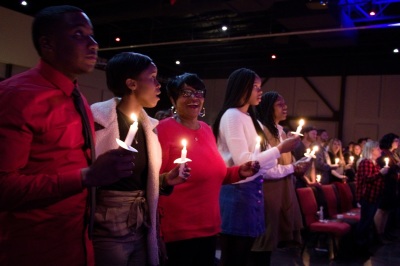How to get young 'Christmas Christians' to engage yearlong

The problem of the “Christmas Christian” is one that’s troubled church leaders for decades. As a former youth pastor, I looked forward to seeing new faces in my youth group around the holiday season. However, once Christmas passed, those “Christmas Christians” disappeared. Ninety percent of Americans celebrate Christmas, but it doesn’t translate into greater engagement with their faith the rest of the year. This is especially true for students, who are increasingly distancing themselves from their faith.
The problem of inconsistent church attendance is symptomatic of a greater issue – that young Americans simply don’t feel connected to their faith.
I think the key to helping students connect with their faith is allowing them to embrace aspects of their faith that might be challenging or uncomfortable. While youth group pizza parties and movie nights can be effective in attracting students to the church, they should be paired with experiences that take the students out of their spiritual comfort zone.
In my experience working with young people, I’ve seen their craving for a faith that is deep and real, and a desire to better understand their Christian identity. We have to push them to understand the raw reality of their faith, especially when that’s hard. They must examine their faith honestly, wrestle with what it means to them, and think about where they fit among thousands of years of tradition and history.
After my time as a youth pastor, I was a personal trainer. Both careers taught me that true strength comes from a healthy relationship with discomfort. You have to place the appropriate amount of resistance on a muscle, and then push. That’s what a faith journey does. When their faith raises uncomfortable questions or demands an examination of identity, students have the opportunity to embrace this discomfort and emerge as stronger Christians. The journey of faith is one of encountering and then engaging with challenge, which ultimately produces resilience and a richer faith.
Romans elaborates on this idea: “We rejoice in our sufferings, knowing that suffering produces endurance, and endurance produces character, and character produces hope, and hope does not disappoint us.”
I am no stranger to a struggle with faith. Becoming a youth pastor was the fulfillment of a long-held dream. But the unhealthy culture at the church where I was working took a toll on my mental, emotional, and spiritual health. At a certain point, I knew that to preserve what I had left, I needed to leave the job I believed to be the calling of my life. I was in a crisis of faith.
A few years later, I spoke to a friend of mine, who told me about a project he was developing that would take thousands of Christian college students to Israel. This friend, Scott Phillips, would become the executive director of Passages, an organization that gives students the opportunity to visit the birthplace of the Bible, affordably and with other students. And I would eventually become its managing director.
Six months after that conversation with Scott, I was standing in Israel. There, I reconnected with the roots of my faith. Three years after leaving my role as a youth pastor, I stood on Mt. Precipice in the north of Israel, reflecting on where God had brought me – back to working with young Christians in a new and fresh way, training them to work through their own doubt, faith, and walk with God.
I thought my calling was dead in the water. Instead, it was waiting for me on that hill in Israel. An uncomfortable journey with my faith had led me to something beyond what I could have ever imagined.
Participants in our program aren’t simply motivated, inspired, or sensationally interested in the region. They strengthen their faith by walking in the real-life backdrops of ancient scriptures and wrestling with the depth and complexity of Israel. They’re confronted with a reality that is probably much different than what they had imagined all their lives.
Students often report mixed feelings when they encounter a familiar Biblical site for the first time, however, this confrontation with the tangible reality of the Bible inspires students to engage more with the Scriptures upon their return. We’ve seen in surveys of our participants that, following their journey, 90% increase how often they read the Bible, 85% increase how often they pray, 67% become more active in campus ministry, and 56% attend church more often.
Seeing Jesus’ birthplace is transformational because it prompts students to grapple with the reality of their faith. As they see the real places of Scripture with their own eyes, they have another opportunity to respond to this reality in belief and action. This Christmas and in the new year, let’s seize the chance to show young people what a true faith experience can be: challenging, honest, and ultimately life-changing.
Jeremy Rivers is managing director at Passages.





















